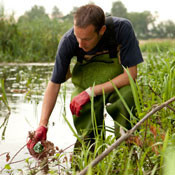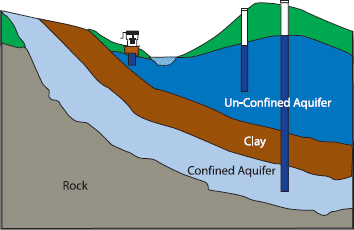Why perform water analysis?
The single most important substance on earth is water. Water plays a crucial role in transporting essential nutrients in plants and animals. Knowledge of water quality is essential for wise economic management of primary production land, control of corrosion in pumping & storage equipment, as well as for the health & well being of livestock and humans.



It’s simple, send us a 300 mL sample of water, or we will come to you for a fee - for E.coli we need to receive the sample ASAP in a sterile container chilled with ice pack to maintain a temperature of 2-8°C during transportation, preferably within 24 hours, with time and date on container to comply with sampling procedures (AS/NZS 2031:2012).
Chemistry: Referenced to 'Standard Methods for the Examination of Water & Wastewater' 23rd Ed. using titration, electrode and spectrophotometric procedures.
Microbiology: E.coli, Thermotolerant (aka Faecal).
Phys Chemistry: pH, Conductivity and Total Dissolved Solids, Total Alkalinity, Turbidity, Calcium Hardness and Total Hardness.
Anions and Cations:- Calcium, Magnesium, Fluoride, Potassium, Sodium, Chloride, Ammonium, Phosphates, Sulphates and Nitrates.
Metals: Iron, Manganese, Aluminium, Boron, Zinc, Copper, Molybdenum, and Arsenic (Sensitivity is according to the requirements of the WHO for drinking water quality).
Calculations:- LSI (Langelier Saturation Index), SAR (Sodium Absorption Ratio).
Report: Compared with the Australian Drinking Water Guidelines (ADWG) - Health & Aesthetic, and the Australian Water Quality Guidelines for Fresh and Marine Waters (irrigation, swimming, livestock, crops).
Microbiology: E.coli, Total Coliforms.
Phys Chemistry: pH, Conductivity and Total Dissolved Solids, Total Alkalinity, Turbidity and Total Hardness.
Metals: Iron, Copper, Aluminium, Zinc, Lead and Nickel.
Report: Compared with the Australian Drinking Water Guidelines (ADWG) - Health & Aesthetic values.
A selection of the above, if not listed, just ask to see if we can do.
Water Analysis - What we test for:-
Microbiology: E.coli, Thermotolerant (aka Faecal) for Bore or Dam water and Total Coliforms for Rain tank water)- by current method AS 4276.5:2019.Chemistry: Referenced to 'Standard Methods for the Examination of Water & Wastewater' 23rd Ed. using titration, electrode and spectrophotometric procedures.
Bore & Dam:
Microbiology: E.coli, Thermotolerant (aka Faecal).Phys Chemistry: pH, Conductivity and Total Dissolved Solids, Total Alkalinity, Turbidity, Calcium Hardness and Total Hardness.
Anions and Cations:- Calcium, Magnesium, Fluoride, Potassium, Sodium, Chloride, Ammonium, Phosphates, Sulphates and Nitrates.
Metals: Iron, Manganese, Aluminium, Boron, Zinc, Copper, Molybdenum, and Arsenic (Sensitivity is according to the requirements of the WHO for drinking water quality).
Calculations:- LSI (Langelier Saturation Index), SAR (Sodium Absorption Ratio).
Report: Compared with the Australian Drinking Water Guidelines (ADWG) - Health & Aesthetic, and the Australian Water Quality Guidelines for Fresh and Marine Waters (irrigation, swimming, livestock, crops).
Rain Tank:
Microbiology: E.coli, Total Coliforms.Phys Chemistry: pH, Conductivity and Total Dissolved Solids, Total Alkalinity, Turbidity and Total Hardness.
Metals: Iron, Copper, Aluminium, Zinc, Lead and Nickel.
Report: Compared with the Australian Drinking Water Guidelines (ADWG) - Health & Aesthetic values.
